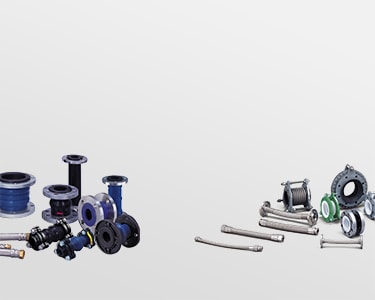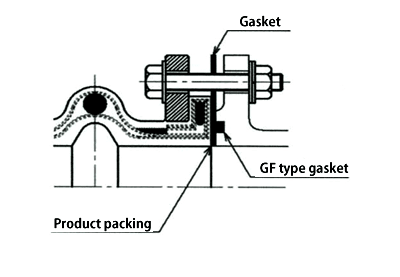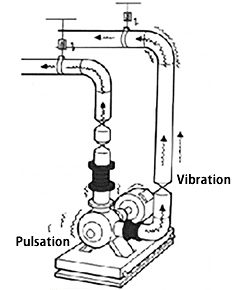
Support
Frequently-asked questions
Selecting flexible joints for use in hot water supply lines
Deterioration by oxidization due to heat or oxygen is one cause of rubber degradation, and is considered to be significantly affected by the amount of oxygen dissolved in fluids.
Particularly for (very) hot water supply lines, as oxygen is constantly supplied in makeup water from external sources, the amount of oxygen dissolved in fluids is high compared to (cool) hot water etc.
in air conditioning lines. In addition, the actions of heat and stress (pressure, displacement, etc.) as well as residual chlorine etc.
in makeup water promote rubber deterioration by oxidization, leading to significant reduction in product service life.
Thus, we do not recommend the use of rubber flexible joints in hot water supply lines due to internal surface degradation and resulting product damage.
We recommend the use of fluoro carbon polymer flexible joints in hot water supply lines, as their wetted parts have excellent heat resistance.
Selecting flexible joints for use around pool water circulation pumps
Disinfection equipment (ozone and chlorine) is often installed close to pumps in pool water circulation lines, leading to high concentration of dissolved oxygen, chlorine, etc., and likely early degradation due to corrosion of rubber flexible joints.
To that end, we have noted in our catalogs that rubber flexible joints cannot be used around pool water circulation pumps, and that we recommend the use of fluoro carbon polymer flexible joints around pool water circulation pumps.
However, rubber flexible joints can also be used around pool tanks and drainage lines (including overflow lines) because the concentration of dissolved oxygen, chlorine, etc.
in pool water is relatively low in those locations.
Rubber flexible expansion joints, rubber flexible joints, and fluoro carbon polymer flexible joints packing.
Rubber flexible expansion joints, rubber flexible joints, and
fluoro carbon polymer flexible joints are fitted with sealing packing used for flange connection on the product main body side. Additional packing is not required.
However, when there are damage or protrusions between the flange connections, our product packing may be damaged and cause problems when using the product.
Please insert a separate gasket (sheet packing).
For “connecting to ductile cast-iron pipes GF type (channel type) flange” and “UFLEX,” please refer to the relevant question(s)
Product attachment bolt dimensions
Connecting to ductile cast-iron pipes GF type (channel type) flange (rubber flexible expansion joints and rubber flexible joints)
Rubber flexible expansion joints and rubber flexible joints are fitted with sealing packing used for partner flange connection on the product main body side. Use together with the GF type gasket (size 1) specifically for ductile cast-iron pipes GF (channel type) flange risks causing the sealing performance to deteriorate due to the sealing surface becoming seat packing of equivalent materials; please insert a gasket (sheet packing) between the packing surface and GF flange for rubber flexible expansion joints and rubber flexible joints.
Please use GF type gasket (size 1) for GF type (channel type) flange-dedicated gasket.

Fluoro carbon polymer flexible joints “UFLEX” packing sealing performance
Fluoro carbon polymer flexible joints “UFLEX” are fitted with fluoro carbon polymer flexible joint flange packing on the product main body side; in principle, there is no need to attach a packing for use between nominal diameters of 20A and 150A.
However, if the flange surface on the other side piping is not smooth due to burrs, etc., when the sealing performance of the packing deteriorates due to degradation over time or when there is a significant change in temperature, there may be instances where a covering packing is fitted.
For instances where such a decrease in hydraulic pressure does not occur, there is no issues if wrap packing is installed.
In addition, for large diameters of 200A to 300A, due to higher surface pressure the above-mentioned drop in hydraulic pressure may occurred earlier, wrap packing is included with the product. Please install it as necessary
The sheet packing model which will be included in the 200A to 300A large diameter products is TOMBO No. 9010-A-5 (Nichias product).
Please use the same model wrap packing as the large diameter for 20A~150A when a drop in hydraulic pressure occurs.
Fluid flow rate limits
Our rubber flexible joint fluid flow rate limit is extracted from General Piping Fluid Flow Rate Limit*1 and we recommend use at 3m/s or below.
Rubber flexible joints can experience change in shape (expansion) to some extent due to the pressure of the fluid; however, as the flow rate increases, the risk of the following faults arises:
- 1.Vibrations occur or increase due to influences of turbulent flow within the pipe.
- 2.Internal rubber wear or damage due to foreign matter in the fluid.
- 3.Due to the suction force generated by the viscosity of the fluid, the body may become flat or the internal rubber may peel off.
Due to the recent improvements in pump performance (reduction in size and faster rotation speed) high flow rate may be more likely; however, please decrease the flow rate to 3m/s or less for piping after the reducer.
※1
Reference documents: Society of Heating, Air-Conditioning and Sanitary Engineers of Japan Handbook 13th edition, Air-Conditioning Equipment Design, Chapter 7 Piping Design 7.2.6 Pipe diameter determination method (3) Pipe diameter selection method.
Rubber flexible joint – Selection of flexible joints for hot spring water
When connecting our flexible joint products in hot spring water lines at bathing facilities, there are two categories under the hot spring supply method: hot water directly from the source and circulating reuse.
When supplying hot spring water to bathing facilities via reuse such as storage or circulation, it is necessary to inject (or supply) chlorine agents into the supply lines concerned (at the early filtration stage) in order to provide sterilization of Legionella bacteria.
It is therefore necessary to classify the applicable materials in flexible joints used around disinfection equipment such as circulation pumps depending on the free residual chlorine concentration in the hot spring water after injection (or supply) of chlorine agents.
The applicable classifications when selecting flexible joint materials based on the hot spring water supply method and residual chlorine concentration are as follows.
| Flexible joint materials category | Hot spring water category/applicable temperature ※2(℃) | Supply method category | ||
|---|---|---|---|---|
| Hot water directly from the source※3 | Storage/circulating reuse※4 | |||
| Free residual chlorine(mg/ℓ) | ||||
| 0.2~0.4 | ~1.0 | |||
| Rubber(EPDM:SK10※1) | ~80 | 〇 | 〇 | △※5 |
| Fluoro carbon polymer | ~150 | 〇 | 〇 | 〇 |
- ※1
- New SK10 rubber materials which feature high resistance to degradation due to chlorine, ozone etc. (the applicable temperature varies depending on the product)
- ※2
- The applicable temperatures of rubber and fluoro carbon polymer vary depending on the product type and line hot water pressure.
Please clarify the working temperature based on the working pressure from the catalog temperature and pressure graphs (the temperatures listed in the tables are the maximum possible product working temperatures) - ※3
- Hot water directly from the source excludes springs where the water is heated or diluted.
- ※4
- Applicable to lines with chlorine agent injection equipment after agent injection
- ※5
- When the residual chlorine concentration is high, degradation will advance even in the SK10, which features high resistance to degradation, so the product life may be shortened. (usage is possible with conditions)
Highly-concentrated ozone and ultraviolet light etc. around disinfection equipment using methods such as ozone and ultraviolet light sterilization causes degradation of rubber, so it is necessary to select flexible joints using fluoro carbon polymer materials for these applications.
Usage limitations with gaseous bodies
(rubber flexible expansion joints and flexible joints)
We manufacture and sell rubber flexible joints and rubber flexible expansion joints which are principally aimed at vibration isolation and displacement absorption in liquid lines.
Because our rubber flexible joints and rubber flexible expansion joints are not designed for principal use in vibration isolation and displacement absorption in air lines, it can be anticipated that the available product working pressure can be easily exceeded and abnormal pressure generated by volumetric expansion of gases due to increased temperature.
Such a situation risks causing product damage, or faults occurring in the internal structure of the rubber owing to the permeation phenomenon due to pressure difference – a characteristic of rubber.
However, the pressure increase in the piping would be expected to be relatively low in the case of an open-end layout using air blowers etc.
Thus, the usage of gases such as air is allowable by limiting the conditions of usage to those in the following table
| Product type | Rubber material | Maximum working pressure (MPa) |
Maximum working temperature(℃) | |
|---|---|---|---|---|
| Rubber flexible joint | EPDM(SK10) CR |
Positive pressure | 300A or less:0.1 | 60 |
| Negative pressure | -※ | -※ | ||
| Rubber flexible expansion joints (LSCONNECTOR) |
ⅡR Special rubber material |
Positive pressure | 150A of less:0.5 200~300A:0.2 350~500A:0.05 550~1000A:0.02 |
70 Depends on product design 80 |
| Negative pressure | -0.1 | |||
※ The fluid is given as a liquid, as per the usage range graph based on the thermal stress for each product (refer to the general catalog)
Additionally, in sealed piping containing compressed air such as from air compressors, the rubber materials of our products – apart from the above situation – swell due to the oil used in the lubrication, shaft sealing, and cooling of air compressors.
Thus, the use of TOZEN rubber flexible joints and rubber flexible expansion joints is not recommended in such applications.
Also, these products are not suitable for use with combustible or toxic gases.
Equivalent pipe length/friction head (rubber flexible expansion joints, rubber flexible joints, and fluoro carbon polymer flexible joints)
Energy loss (friction head) is generated through fluid friction as fluids pass through our flexible joints and flexible expansion joints. The friction head values from our products converted to equivalent pipe length are reported as follows. Please refer to them as the sectional head loss (equivalent pipe length) when calculating the friction head for the entire length of piping.
| Category | Applicable products | Equivalent pipe length |
|---|---|---|
| Rubber flexible joint | BFCONNECTOR | 2.0m |
| KINGFLEX 20 | ||
| TOZENFLEX | ||
| TOUGHBOY | ||
| PURE JOINT | 3.0m | |
| PTCONNECTOR | 4.0m | |
| TOUGHLEX | ||
| ELBOFLEX | 2.0m+a※1 | |
| Rubber flexible expansion joints | LSCONNECTOR | 1.0m+ number of bellows×1.0m |
| LCCONNECTOR | ||
| Fluoro carbon polymer flexible joints | U-FLEX | |
| FLONEXa | 4.0m | |
| FLONEXa T-3 |
※1 Bend equivalent pipe length
| Nominal diameter | 32A | 40A | 50A | 65A | 80A | 100A |
|---|---|---|---|---|---|---|
| a | 0.6m | 0.7m | 0.9m | 1.1m | 1.3m | 1.7m |
| Nominal diameter | 125A | 150A | 200A | 250A | 300A | |
| a | 2.1m | 2.5m | 3.3m | 4.1m | 4.9m |
Fire Service Act friction loss calculation standards (Extracted from Welded type 90° short elbow)
Technical points
The following are commonly-received technical questions about our products.
We have installed vibration-isolating frames and rubber flexible joints on the pumps in our machinery room, but vibration and noise are reaching the floors above it.
We want to know what the causes and solutions could be.
1.Does the horizontally- and vertically-installed piping have vibration-isolating supports?
If not, please take vibration-isolating measures
2.Have you back-filled the holes where piping passes through frames (of walls and floors) with mortar etc.?
Where mortar has been used, please remove it and replace it with rockwool
Do you have any concerns about vibration isolation only with pads?
Simply placing pads is likely to provide sufficient cushioning materials when no attention is paid to vibration and noise generated depending on the equipment capacity and location of installation. The standard applied load per 1cm2 of pad is approximately 2-4kgf/cm2. Pads function more as cushioning than vibration-isolating material, and are not an appropriate choice of material when aiming to prevent generation of vibration.
If we use rubber flexible joints around pumps, then do we really need vibration isolation supports on horizontal and vertical piping?
Piping vibration can be caused by pulsation due to pressure fluctuations within the piping and vibration from the machinery itself. Rubber flexible joints are likely to be effective against mechanical vibrations. However, vibration caused by pulsation due to pressure fluctuations within the piping occurs throughout the length of the piping, so installation on the horizontal and vertical piping past the rubber flexible joint attachment point of vibration isolation supports suiting the intended usage of the building is also necessary.

How should we treat vibration isolation underground or from a machinery room?
Vibration is likely to be irrelevant when the floor directly above machinery installed underground is a parking lot etc. When the floor directly above is a lobby, offices etc., care must be paid to vibration isolation for ceiling-suspended piping and large ducts. However, installation of rubber vibration isolators is often sufficient if some consideration is given to the types of machinery installed underground. On the other hand, although there is some variation depending on the usage of the building, it is often necessary to pay attention to the noise level around machinery rooms in intermediate floors, increasing the need for vibration isolation of equipment, piping, and ducts. Care must be paid to vibration-isolating suspension of hot and cold water piping not only inside machinery rooms but also where it runs horizontally outside machinery rooms along corridor ceilings, as well as vibration-isolating suspension of horizontal hot and cold water piping which reaches up to the roof.
Contact
General Affairs Department, TOZEN Corporation
8-4 Asahi, Yoshikawa, Saitama, 342-0008 Japan
Phone: +81-050-3538-2091
Business hours: Weekdays 9:00AM to 5:00PM Japan time
